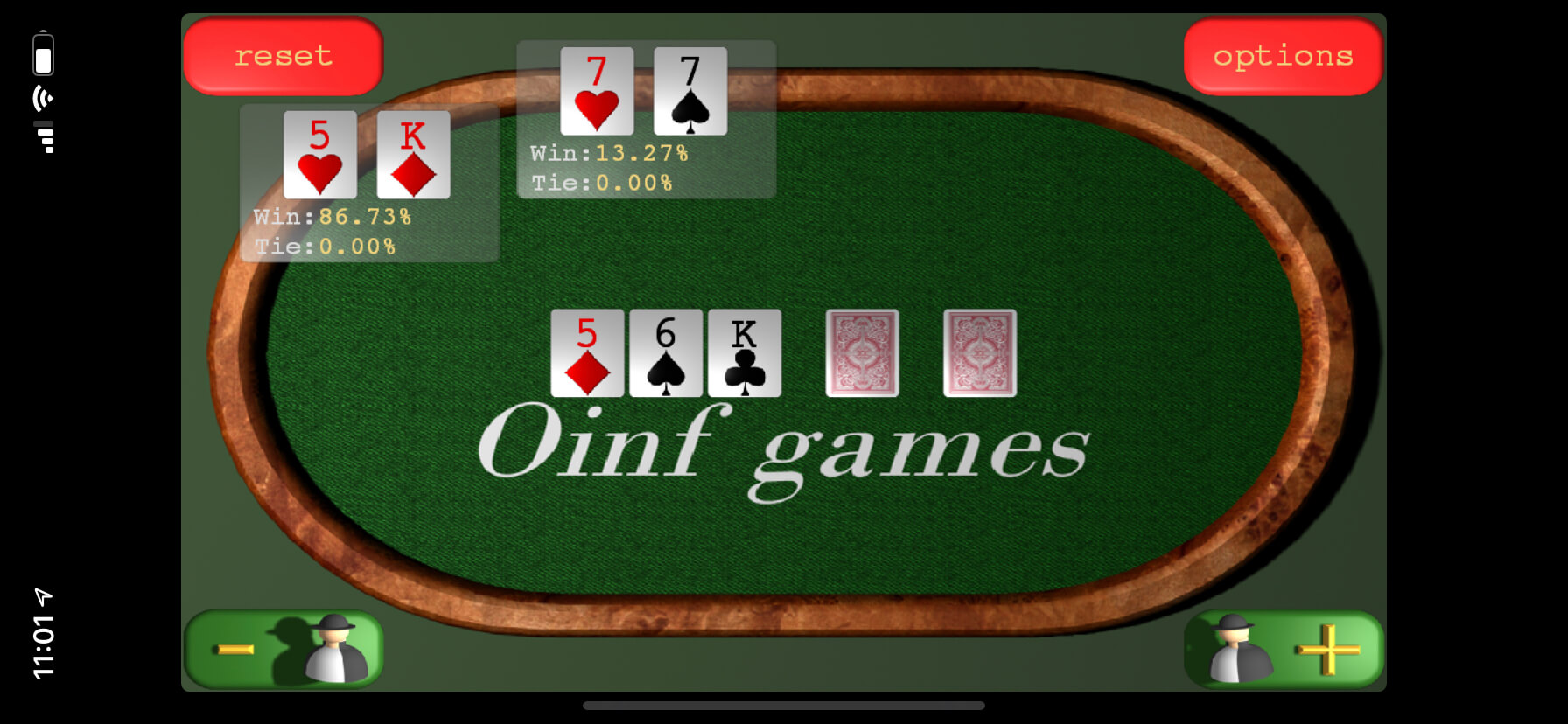If You Tie In Poker Who Wins
Rank of poker hands. The rank of standard poker hands is determined by their odds (probability). Two or more identical hands tie and divide any winning equally. The suits have no relative rank in poker. When there is any wild card in the game, the highest possible hand is five of a kind, which beats any straight flush. Second pair wins. If both pairs tie, the high card wins. Pair Any two cards of the same denomination. Our example displays a pair of queens. In a tie, the the high card. High Card If no other hand is achieved, the highest card held wins. In our example, the ace of hearts is In the case of a tie, you move.
| 1. | 888 poker | n/a | 888poker.com |
| 2. | PokerStars | n/a | PokerStars.com |
| 3. | Party Poker | PPAL500 | Partypoker.com |
Must be at least 18 to open a new account
What happens when two or more players have the same poker hand? How do you determine who wins? This page will guide you through all the poker hands and show you how to determine the winner, or when to declare a tie. This article assumes you already know about how poker hands are ranked. If you don’t, please read our poker hand ranking page before going any further.
kicker
A “kicker” is often used to determine the winning poker hand. For example, let’s say two players both have a pair of aces. Play one has A-A-K-8-3 and player two has A-A-j-3-2. The kicker is the highest card excluding the pair of aces. In other words, the kicker for player one is a king, and for player two it’s a jack. Since a king is better than a jack, player one has the best hand even if both players made a pair of aces. If the kicker also was tied, then you compare the next higest card. For example, if player one has A-A-K-4-2 and player two has A-A-K-5-4, you can take out the aces and kings from both hands. You are left with comparing a 4-2 with a 5-4. Player two has the highest card (a five) thus has the best hand. This is how you use kicker cards to determine the winning hand.
Poker Hands
Royal Flush
Since all suits are equal, all royal flushes are equal. The probability of seeing two royal flushes played on the same hand are likely comparable to the probability of getting struck by lightning so don’t expect to encounter this situation!
Straight Flush
If there are two straight flushes, the one with the higher top card is the best. The suit of the flush does not count in determining the wining hand as all suits are considered equal. If two flushes are ranked in the same sequence, then it’s a tie.
Four of a Kind
If two people have fours of a kind, the player with the higher ranking set of four cards has the winning hand. Thus, the player with four jacks has a better hand than the player with four tens. Kickers are not used so the fifth card is irrelevant.
Full House
A hand with three cards of the same rank and two cards of another rank. An example is A-A-A-2-2 (called Aces full of 2s). If two players have full houses, the one with the higher ranking three cards is the winner. For example, tens full of 3s (10-10-10-3-3) beats fours full of Aces (4-4-4-A-A). Someone will always have the better Full House hand and kickers are not used.
Flush
If two players have flushes, the highest card determines which is the winning poker hand. If the highest cards are equal then the second highest card is used to determine the winner, and so one. In other words, use the kickers to determine the winner. For example: 2-4-5-8-9 all in spades beats 2-3-5-6-7 all in clubs because you compare the highest card (9 vs 7). All suits are equal.
Best Flush Example:
- 10-3-8-K-A (suited) beats 9-4-J-Q-K (suited) – Highest card is A vs K.
- Q-10-9-5-2 (suited) beats Q-10-3-6-5 (suited) – since the two top cards are the same in both hands, the third card determiens the winner. In this example, 9 beats 6.
Straight
When comparing two straights, the one with the highest ranking top card is better. An Ace can ONLY count high or low in a straight. For example, A-2-3-4-5 does not beat 10-J-Q-K-A. Also, Q-K-A-2-3 does not count as a straight because the ace doesn’t count as either the low card or the high card. A tie can occur when two players make the exact same straight based on the card ranks, and card suit is irrelevent. Unless of course it results in a straight flush explained earlier.
Best Straight Example
- 2-3-4-5-6 beats A-2-3-4-5
- 10-J-Q-K-A beats 9-10-J-Q-K
- 4-5-6-7-8 ties 4-5-6-7-8
Three of a kind
The highest three of a kind when comparing two hands is ranked better. For example the hand 8-8-8-3-2 beats 5-5-5-A-Q. Unless wild cards are used, a tie cannot occur. Someone will always have the better Three of a Kind hand.
Two pair
If both players have two pairs, the hand with the highest pair has the winning poker hand and the smaller pair is irrelevant. For example, Q-Q-5-5-3 beats 10-10-7-7-A because the queens beat the tens. If the higher pairs are the same then the smaller pair is used to determine the higher ranking hand. Q-Q-10-10-4 would beat Q-Q-9-9-K. If both pairs are the same then kicker cards are compared.
Best Two Pair Example
- A-A-3-3-5 beats K-K-J-J-9
- K-K-3-3-5 beats K-K-2-2-A
- K-K-3-3-5 beats K-K-3-3-2
Pair
The higher pair determines the best hand. If two players have the same pair then the highest card is used. If this card is the same, then the second highest card is compared and finally the third if it comes down to it.
Best Pair Hand
- 8-8-3-2-5 wins over 5-5-A-K-J
- 10-10-A-2-5 wins over 10-10-K-Q-10
- J-J-K-10-5 wins over J-J-K-9-8
High Card
If two players have none of the hands above, then the highest card wins. If the highest cards are the same then the second highest are compared and so on. Use the kicker rules.
Best High Card Example
- A-8-3-2-5 beats K-Q-J-10-3
- A-K-3-2-5 beats A-Q-J-9-5
Related Entries
Related posts:
On This Page
Introduction
After doing math analysis and consulting on about 200 games for game inventors I learned a thing or two. One is that games that are totally out of left field have almost no chance. If you can't explain the rules of a game in under 15 seconds players won't have the patience to learn it, dealers will make errors, and casino management likely won't give it a chance in the first place. Games that have the best chance to succeed are blackjack and poker variations, because players already understand the basic rules of those games. With the exception of Casino War all successful new table games have taken blackjack or poker and introduced just one major rule twist.
Most blackjack variants I have tried let players do something they couldn't do before, meanwhile turning some wins into ties or ties into losses. In my opinion the market is saturated with such games but the door is open for the opposite, a game that turns ties into wins by taking away some choices. That is why I created Ties Win Blackjack. The game pays 1 to 2 on all ties, mostly by taking away the option to double and split. The game is easy to learn, easy to deal, and the strategy is almost the same as regular blackjack. It is also a better bet for players than most blackjack games. I'm not saying every player will like it but hope players looking for a simpler or less volatile version of blackjack will like it.
The game completed a field trial at the Edgewater casino in Laughin Nevada in May 2005. Currently it is not available in any land casinos but previously could be played online at Red Lounge Casino.
Rules
The rules are the same as blackjack except as noted below.
- All ties pay 1 to 2.
- Player may only hit and stand.
- Winning blackjack pays even money.
The following tables show the strategy according to whether the dealer hits or stands on soft 17. These tables are correct for any number of decks.
The player will get a tie about 8.75% of hands.
House Edge
Following are the effects of the changes to regular blackjack, based on infinite decks.
- Player may not double: loss of 1.47% to the player.
- Player may not split: loss of 0.58% to the player.
- Winning blackjack pays 1 to 1: loss of 2.25% to the player.
- Player wins 1 to 2 on ties: gain of 4.37% to the player.
Over all this adds up to a loss of 0.07%. It is actually a little bit less at 0.02% because of an interaction effect.
The following table shows the house edge for various number of decks and whether the dealer hits or stands on soft 17.

Ties Win Blackjack House Edge
| Decks | Dealer Hits on Soft 17 | Dealer Stands on Soft 17 |
|---|---|---|
| 1 | 0.247% | 0.003% |
| 2 | 0.400% | 0.150% |
| 3 | 0.445% | 0.193% |
| 4 | 0.467% | 0.214% |
| 5 | 0.480% | 0.226% |
| 6 | 0.489% | 0.233% |
| 7 | 0.495% | 0.238% |
| 8 | 0.500% | 0.242% |
| ¥ | 0.531% | 0.269% |

Play my on Ties Win Blackjack Java game.
Harrods Casino
Ties Win Blackjack was available for play in U.K. pounds at the Red Lounge Casino. The Red Lounge used one deck and the dealer hit a soft 17, for a house edge of 0.247%.